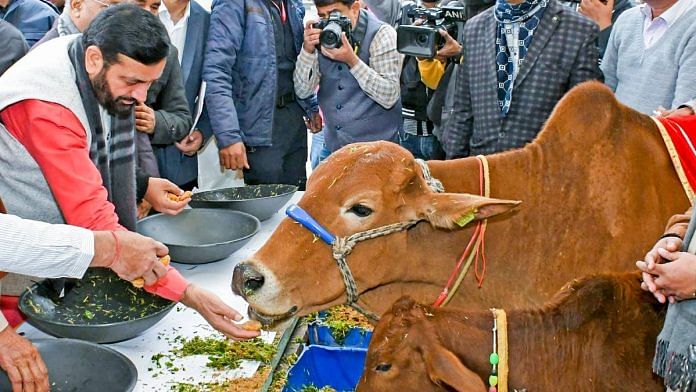Gurugram: The Haryana Gau Seva Aayog—a body established in 2010 for cow protection in the state—has seen its budget expand more than 250-fold in the decade the Bharatiya Janata Party (BJP) has been in power, reaching Rs 510 crore in 2024-25 from Rs 2 crore in 2014-25.
Chief Minister Nayab Singh Saini highlighted this Tuesday while announcing a slew of incentives to promote cow protection and support industries manufacturing products using cow dung and urine—from soaps and shampoos to organic paints, pots, diyas, hawan samagri and bricks.
Ever since the BJP came to power in Haryana under Manohar Lal Khattar in 2014, it has taken a series of steps for the protection of cows, including stringent laws and funds for the rehabilitation of stray cattle. At the same time, the state has come under the lens over self-styled cow vigilantes operating beyond the bounds of the law, often accused of lynchings and violence in the name of cow protection.
Though the Haryana Gau Seva Aayog was set up during the previous Congress government, the BJP government made this body more active.
Its website says it was established under Section 3 of the Haryana Gau Seva Aayog Act, 2010, enacted by the legislature for the “preservation and welfare of cows” in the state. The body’s “main objective is to work for the proper implementation of laws with respect to the prohibition of slaughter and/or cruelty to cows”, it adds.
The body’s chairman, Shrawan Garg, welcomed Saini’s announcements, saying the BJP government’s efforts had transformed cow protection in Haryana.
“During the Congress’s tenure, there were only 215 registered gaushalas with 1.74 lakh cows. Today, we have 683 registered gaushalas housing 4.5 lakh cattle,” he said.
He added that the body has reduced the number of stray cattle roaming on the roads to less than 40,000 from 1.5 lakh, and asserted that the number would drop to zero by 31 March.
Garg further said that the incentives for industries would go a long way in helping the state government’s endeavours to protect cows, citing examples of successful efforts such as getting entrepreneurs to set up units for the manufacturing of organic paints and fertiliser.
Saini’s announcements at an event in Panchkula district Tuesday also included the release of a fodder grant of Rs 216.25 crore and additional measures to support gaushalas.
“Solar energy plants have already been installed in 330 gaushalas, and efforts are under way to extend this to all remaining facilities,” the chief minister said. He also said gaushalas were receiving electricity at a subsidised rate of Rs 2 per unit, reducing their operational costs.
The chief minister also talked about the government’s efforts to make Haryana a stray cattle-free state, with incentives for gaushalas that house stray animals. The government will pay Rs 300 for calves, Rs 600 for cows, and Rs 800 for bulls taken in by gaushalas, he said.
“Stray cattle often cause accidents. Addressing this issue is a priority for the government,” said Saini.
(Edited by Sugita Katyal)
Also read: Dhanpat Singh Saangi Memorial Award brings focus back on Haryana’s traditional saang art form







Cows are the only creatures who feel protected in Haryana. The women most certainly don’t. Neither do the Dalits and other oppressed castes.
Haryana has always been more concerned with cows than human beings. People elect their leaders to ensure the safety and security of cows first; humans are an afterthought. No wonder the Haryana administration is more bothered about the safety of cows. Security of human beings is always an afterthought.